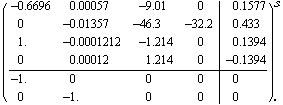|
4.3 Controllability and Observability Tests Using Block Hessenberg Forms
The controllability and observability of a system can be tested by transforming the matrix pairs  and and  , respectively, to the controller-Hessenberg and observer-Hessenberg forms described earlier in this chapter. The system is controllable (observable) if and only if the controller-Hessenberg (observer-Hessenberg) form is unreduced; that is, each subdiagonal (superdiagonal) block has full rank. These tests are used, by default, to test controllability and observability in Advanced Numerical Methods. , respectively, to the controller-Hessenberg and observer-Hessenberg forms described earlier in this chapter. The system is controllable (observable) if and only if the controller-Hessenberg (observer-Hessenberg) form is unreduced; that is, each subdiagonal (superdiagonal) block has full rank. These tests are used, by default, to test controllability and observability in Advanced Numerical Methods.
The block Hessenberg forms also provide the controllability and observability indices. The controllability index is immediately known as soon as the controller-Hessenberg form is determined. If the last block on the subdiagonal  is 0, then only the first is 0, then only the first  inputs are controllable. If some of the subdiagonal blocks are nearly rank-deficient, then the system is close to being uncontrollable. In this case, the feedback gains to stabilize the system or to assign the poles may be quite large. Similar features hold for the observability index. inputs are controllable. If some of the subdiagonal blocks are nearly rank-deficient, then the system is close to being uncontrollable. In this case, the feedback gains to stabilize the system or to assign the poles may be quite large. Similar features hold for the observability index.




New tests for controllability and observability.
Make sure the application is loaded.
In[1]:=
Load the collection of state-space systems.
In[2]:=
This is a state-space model of an F-8 aircraft.
In[3]:=
Out[3]=
Because the controller-Hessenberg form is unreduced, the system is controllable.
In[4]:=
Out[4]=
The function Controllable verifies the controllability of the system.
In[5]:=
Out[5]=
Because the observer-Hessenberg form is unreduced, the system is observable.
In[6]:=
Out[6]=
The function Observable verifies that the system is observable.
In[7]:=
Out[7]=
|